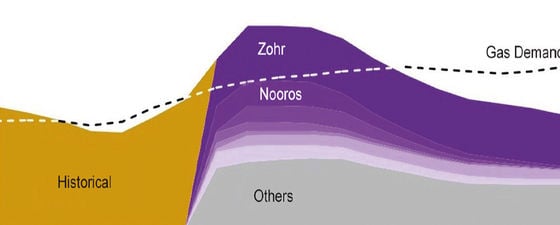Egypt became a net importer of LNG in 2015. However, the country announced its intention to cease imports and begin exporting LNG through its main LNG terminal at Damietta in 2020.
Egypt is in the middle of a supply turnaround. The gas-rich country became a net importer of LNG in 2015 after domestic production failed to keep up with LNG supply commitments; however, the country announced its intention to cease imports and begin exporting LNG through its main LNG terminal at Damietta in 2020.
The volumes to support this restart will come from the surplus gas production of about 550 MMcfpd at the giant Zohr field, where production reached 2.7 Bcfpd at the end of 2019. Supply to the three LNG trains in Egypt − Shell-operated Idku T1 and T2 and Eni-Damietta T1 − will produce 1.42 million tons a year in 2020. The uptick occurred after Shell and the Egyptian General Petroleum Corporation (EGPC) renegotiated the contracts for the Burullus and Rosetta fields. In addition to these volumes, West Nile Delta, Nooros, Atoll and Baltim South West will all be major contributors to this ramp up.
Egypt’s gas supply and demand balance (Bm3). Source: Rystad Energy Upstream Analytics.
Earlier, Cyprus received permission from the EU to construct a subsea pipeline to Idku in Egypt to target growing demand in international gas markets. In Israel, Noble Energy signed a long-term contract in September 2018 with Dolphinus Holdings, an Egyptian consortium, to sell 64 Bm3 of gas over a 10-year period from Tamar and Leviathan into the Egyptian domestic market through the existing East Mediterranean Gas pipeline. With in-place export infrastructure and growing domestic demand, Egypt is well positioned to serve as a gas export hub for the region.
Egypt’s hydrocarbon production is set to rise to about 2.2 MMboepd in 2020, thanks to supply additions from Baltim South West and Zohr. With this, Egypt will have brought most of the resources discovered to date online. Further ramping up and maintaining production levels will be contingent upon future discoveries. In the recent past, Egypt has awarded relatively unexplored blocks to majors, so success or otherwise on these has potential to change the production outlook.
Top Hydrocarbon Discoveries in Egypt
The Zohr Gas Field
The Zohr gas field was discovered by Petrobel in 2015 in the Shorouk block, with the gas found in a Miocene Carbonate reef reservoir. Petrobel is a 50/50 joint venture between Eni and EGPC. The field was brought online in 2017 and currently produces over 2.5 Bcfpd. Rystad Energy estimates that the field holds a total of 3.55 Bboe of recoverable gas.
The Nooros Gas Field
The Nooros gas field was discovered by Petrobel through drilling a directional well to a depth of 3,600m. The well struck a 60m-thick gas-bearing sandstone reservoir of Messinian age. The field was brought online in July 2015 and it is currently producing about 1.2 Bcfpd of gas. Rystad Energy estimates that the field holds over 650 MMboe of recoverable gas reserves.
The Atoll Gas Field
Pharonic Petroleum Company, a 50/50 joint venture between BP and EGPC, discovered the Atoll gas field in the North Damietta offshore concession in 2015. The exploration well encountered 50m of gas pay in an Oligocene sandstone reservoir and the field was brought online in 2016. Rystad Energy estimates the field to hold about 250 MMboe of recoverable gas reserves.
Further Reading on Oil and Gas Exploration in Egypt
Exploration Update: Major Oil Discovery in Egypt
GEO ExPro
Major oil discovery announced in the prolific Abu Gharadig Basin of Egypt’s Western Desert.
This article appeared in Vol. 16, No. 1 – 2019
Hydrocarbon Developments in the Eastern Mediterranean
Brought to you in association with NVentures
Hot Spot: Ten gas discoveries across Egypt, Israel & Cyrprus define the East Mediterranean Hydrocarbon hotspot.
This article appeared in Vol. 15, No. 3 – 2018
Frontier Exploration in Egypt’s Mediterranean Sea
Simon Baer, Øystein Lie, Matthew Pyett, Chris Davies, Rune Sakariassen; PGS & Aymen El Morshedy; EGAS (Egyptian Natural Gas Holding Company)
Several promising play types can be identified on new pre-stack depth migrated seismic.
This article appeared in Vol. 14, No. 5 – 2017
New Opportunities Offshore West Egypt
Simon Baer, Øystein Lie (PGS) and Ayman Almorshedy (EGAS)
Hydrocarbon exploration success offshore Egypt to date is mainly associated with the prolific Pliocene sequence in the Nile Delta Basin, but as the recent Zohr discovery shows, there are other potential plays to follow. Here, we look at the relatively unexplored area of offshore West Egypt.
This article appeared in Vol. 13, No. 1 – 2016
Advertisement





